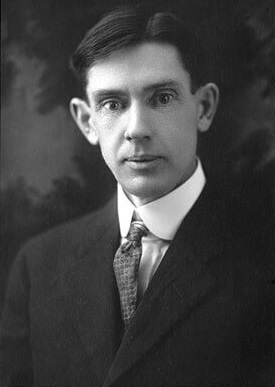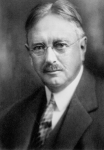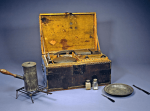![]()
Elmer McCollum, 28, started the first colony of small lab animals for nutrition experimentation in the United States in 1907. He was a new PhD working under E.B. Hart in the College of Agriculture at the University of Wisconsin in Madison. His project was to find out why cows became malnourished when fed a single plant, such as oats or corn.
McCollum came to realize that the plants were too complex and cows too big and slow-growing for him to get anywhere with this research. Here are two accounts of what happened next. The first is from 1967:
“It also occurred to me that experiments should be made with small animals. They grew to maturity in a short time, reproduced, reared young, and had a short life-span. They ate little, so one could afford to do the necessary chemical work on the diets. The life history of the animals could be observed.
While engaged in these speculations I became convinced that the project we were engaged in with cows, fed highly complex chemical rations could not lead to the discovery of anything of importance and that I was wasting my time.
I was in a predicament, because Professor Hart was elated by his cow experiment and it had been given wide publicity. Animal husbandrymen were enthusiastically discussing it. The discovery of what was wrong with the wheat ration would reflect great credit on us. But I was 28 years old. It was imperative that I accomplish some thing of scientific worth to gain advancement and establish myself as a productive scientist. It was dishonest for me to continue accumulating analytical data which I considered worthless, so it was imperative that I divulge my thoughts and take the consequences.
Professor Hart was astonished and of fended at my pronouncement on the cow project. He was contemptuous of my suggestion that we turn to the rat as an experimental animal. I was at fault in wanting to abandon so soon the project on which I had agreed to work. Our interview was brief and stormy.
Two days later I told about my speculations to Emeritus Professor Steven M. Babcock. He responded enthusiastically, saying that mine was the best suggestion he had ever heard of for study of foods and nutrition. He took me to the office of Dean H. L. Russell and asked me to tell him of my ideas. Dr. Russell’s answer was an emphatic “no.” The rat was a farm pest and it would never do to spend Federal and State funds on experiments with rats. Dr. Babcock was the most honored man in the College of Agriculture, and because he insisted that he wanted to know what could be learned by my plan, I was meekly permitted to set up my rat colony. No formal project was made of my enterprise, and no funds were allocated for its support.
I made cages out of boxes in which supplies came to the laboratory. I needed quarter-inch wire netting for one side, and placed on Professor Hart’s desk a requisition for two dollars’ worth. He declined to sign it and I bought it out of my $1,200 annual salary. I caught wild rats and tried to use them, but they were so frightened and ferocious that I discarded them and bought, at my own cost, a dozen albino rats from which I built up my colony.”
from the Journal of Nutrition (full-text)
And an earlier account from 1953:
“The necessary chemical work in the preparation of the foodstuffs required precluded the use of large animals. Small animals have short periods of growth and mature early. Their periods of reproduction and suckling of the young, and their life span are such that the life history can be observed in two to three years.
It was this plan which involved the use of rats, that I presented to Dr. Babcock on a Sunday morning in November, 1907. He was highly enthusiastic about the possible achievements which might come from nutritional research by following a plan in which we would proceed from the simple to the complex rather than attempt to find why complex natural feeds in certain combinations and from certain sources failed to sustain health.
With his approval and support I was able to start experimenting with rats. Mine was the first rat colony in America maintained for nutrition studies. At first I tried to use wild rats, but they were so frightened under caged conditions and were so ferocious that I soon abandoned them for albinos which I bought from a pet-stock dealer in Chicago.”
Annual Review of Biochemistry (full text)
McCollum’s praise of Steenbock has a certain irony. According to vitamin A researcher Richard A. Semba of the Johns Hopkins University School of Medicine, when McCollum moved to Johns Hopkins he left Wisconsin “under a cloud of ethical impropriety and academic misconduct.” According to Semba, McCollum stole the research notebooks of his colleagues, including Steenbock’s, published their data without their consent or acknowledgement, and purposely sabotaged their animal experiments. In his subsequent writings, McCollum attacked his rivals at Wisconsin, often by giving a deliberately distorted or false presentation of their achievements. Semba makes it clear that McCollum was not liked by his peers.
from: Richard A. Semba: On the ‘Discovery’ of Vitamin A. Annals of Nutrition & Metabolism. 2012; 61: 192-198.



